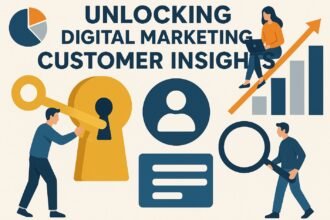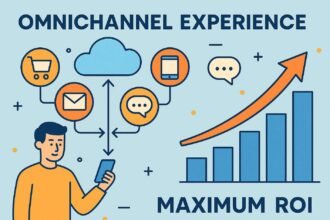Setting the Stage for Modern Marketing
Marketing analysts agree that the path to future success passes through the door of the unique. The growing demand for content that elevates each product, brand, and offer makes experiences the basis of the purchase and creates an ongoing relationship that continuously fuels it.
Tracking every consumer action and reaction is key to delivering content in which everyone, at every moment, hears their name. Other technologies, such as AI and automation, deal directly with the timing, channel, and frequency at which the communications reach the customer. Data allows professionals to deliver unique options and personalized resources and enhances customer service as never before. Having a team dedicated to managing moments and surprises undoubtedly increases sales and creates real pleasure for anyone who has a product or brand.
The Evolution of Marketing
Marketing has always been a dynamic discipline, transforming to meet the current needs of its target market and the environment; neither can remain static. Currently, the marketing landscape changes daily due partly to the growing expectations of customers. With more information available than ever before, customers no longer simply purchase goods; they seek emotional connection with the brands by which they are attracted and captivated. To stand out in this competitive environment, a marketing strategy that focuses on making each experience unique must be developed.
In the early days of marketing control by companies and brands, one-way communication predominated because consumers had no other sources of information or other brands to choose from. The development of brands destined to mass production brought about a change, owing to the need to find new markets for these products. Next came the era of information, which profoundly altered the nature of companies, consumers, and the market environment. Today, in the phase of unrestricted communication, consumers have complete freedom to express whether their needs are being satisfied.
Understanding Consumer Behavior
Creating a unique experience for consumers is more than simply providing a product. Again and again, we purchase services or products for other reasons beyond the product itself: the Starbucks experience, the teammates with whom we play golf, or the friendly pharmacy assistant asking about our families. All these elements together lead us to make purchasing decisions. Marketers therefore are trying to deliver these unique experiences. Being able to recognize a customer and identify exactly what he likes and does not like, understanding his mood after a specific situation, or knowing if he is dissatisfied after a poor service are all within reach of today’s marketers.
Why should customers accept a generic customer experience message? When they use Facebook, Google, or Amazon, they receive a set of services that are tailored to their particular wants and needs; moreover, when using Google, they receive advertisements in line with their profile or their last search—assuming, of course, that they have accepted the provision of such information. Yet, organizations still do not provide a similar service. Why should customers accept being treated as another number? Today’s world offers customers the opportunity to purchase services and products from different parts of the world; furthermore, social media give them a chance to express their dissatisfaction. Knowing all these factors, it is easier to understand the importance of delivering customized unique experiences.
Personalization in Marketing
Personalization is the core of modern marketing. Consumers no longer want similar ads; they want unique experiences and different marketing for each phase of their customer journey. Marketers must pursue customers in their right moment, with the right ads. Consumers are looking to feel known and want businesses to recognize them across every platform.
The marketing profession is nearing a transformation. Businesses no longer have the luxury of repetition, and risk becoming diluted if they keep blasting similar messages to a growing consumer base. The pursuit of using unique content for each phase of the customer journey could bring the industry closer to a golden age. With nearly 90 percent of data-bound tasks set to be automated by 2024, marketers will finally be able to shape strategies, not hop between dashboards. Adopted properly, artificial intelligence will inject speed into every process while eliminating human bias.
The Importance of Personalization
Marketing has changed dramatically over the past several years. Individuals are exposed to thousands of brand messages a day but struggle to be interested in most of the input they are flooded with. The modern consumer is looking for something unique and compelling to hold their attention and encourage them to engage with a company or brand. Likewise, the transformation of marketing into a two-way dialogue requires brand responses that are just as unique for the audience and that adapt to the audiences’ concerns and comments.
The impact of the digital era is profound: everyone is now demanding an experience that’s uniquely configured and tailored to their preferences and desires. Brand experiences must provide consumers with the sense of a special offer, with benefits beyond promotional values, with the perception that everything is designed and crafted to meet their specific needs and wants. This has placed enormous demands on marketers and communication professionals, guided by the simple yet powerful principle of creating very-close-to-one ones-to-ones consumer relationships and exploiting every customer touch point for marketing and communication purposes.
Techniques for Effective Personalization
As marketers seek to enhance customer engagement and conversion rates, an increasing emphasis is being placed on delivering engaging marketing moments that acknowledge each customer’s distinctiveness. The customer-centric approach is not novel; history demonstrates how the development of consumer society necessitated understanding consumer needs through marketing, and how production methods have shifted with changing demand. Moreover, the digital revolution has altered buying and information search processes, leading to a redefinition of the brand concept and changes in communication. Personalization thus becomes a core focus of modern marketing.
Recent studies on personalization have analyzed models proposed by individuals, categorizing the use of customer information based on dimensions such as decision-making, targeting, implementation, presentation, and privacy. Additionally, investigations into the relationship between personalization and target group revealed that internal marketing management plays a pivotal role in customizing relationships with clients. Although the necessity of personalizing knowledge management is widely acknowledged, understanding the breadth of these functions in practice underlines the importance of applying such knowledge in a way that continually adapts to each customer’s evolving needs and desires.
Data-Driven Marketing
Today, customers, prospects and clients are not merely a statistic or anonymous target group. Technology and social media have empowered consumers, allowing an inaccessible and passive audience for marketing to turn into an active audience providing constant feedback to organisations. It is possible to collect data about how customers interacts with a company and collect information about their personal preferences and behavior. Opening up complete transparency and allowing a 360-degree view of the customer, giving organizations an unprecedented opportunity to deliver excellence in customer experience.
The next customer experience can be a unique experience. It can still be delivered to millions of customers, yet it is still perceived as a unique experience. And this is the basis for the future of marketing: making every experience that customers have, feel like they are the only one that matters, making every experience uniquely personal.
Collecting Consumer Data
Marketers have long understood the power of personalization and one-to-one communication. Advertising messages featuring consumers’ names have appeared in the print media for over a century. Dollar Shave Club uses consumer-product relationships to create customized messages that build engagement with consumers and guide them through every step of the customer journey. Netflix has led on data-based services for decades, creating deeply customized journeys for viewers by tailoring everything from personalized homepage experiences to the thumbnails displayed for shows and movies. These ongoing trends help marketers meet the growing expectations of today’s consumers.
For businesses, the process begins with data collection. On websites and e-commerce platforms, tracking pixels gather large quantities of consumer data. Customer relationship management—CRM—software tracks user activity based on interactions with past campaigns and sales teams, typically encompassing a dozen or so fields of information. Enterprise resource planning solutions capture important details about users, especially when coupled with payment transaction data. Modern data-processing technologies enable the collection of both structured data—details like age, gender, income, location—and unstructured data, including behaviors, interests, transactions, and psychographics. As the technologies underpinning these data warehouses continue to evolve, they make greater quantities of data available to marketers across the organization.
Analyzing Data for Insights
Preferred brands combine a thorough understanding of their customers with knowledge of which products work best for them and why, to avoid annoying customers with product suggestions that they are likely to reject, and to hone more effective marketing campaigns. For example, Google collects and tabulates data on who was searching for “back to school” or “anti-inflammatory” last year, then determines which customers responded positively to retail banners last season—clicking through or making a purchase or a booking, and so on. These insights allow search engine marketers to adjust bids for specific keywords or add new ones to their campaigns, and to market each customer in a way that yields a greater return on their investment.
In consumer credit markets, capital markets feed anonymized default rates, interest rates, and balances into a central data warehouse every three months. They mine this data to create sets of key performance indicators for each credit product. Through this detailed quantitative analysis, credit analysts gain insight into the value of existing portfolios relative to competitor portfolios, as well as the level of risk associated with future new business. These indicators influence decisions around credit pricing, policies, and lending limits, resulting in products that satisfy credit customers’ needs yet do not assume excessive risk.
The Role of Technology in Marketing
Innovative technologies profoundly impact marketing strategies, making customer journeys optimal with timely and personalized communications. Personalizing customer interactions enables businesses to proactively address clients’ needs through omnichannel approaches. Consequently, seamless marketing communications across various channels—such as SMS, email, and social media—are indispensable.
Automation tools form the backbone of such marketing strategies. Products use artificial intelligence (AI) to examine complex relationships between content, timing, frequency, and medium of customer interactions. This analysis discerns the increasing likelihood that a buyer will find online listings appealing. Integrating AI-powered technologies like Google Smart Bidding—where machine learning adjusts bids for each auction—and Google Responsive Search Ads, which automatically test various combinations of headlines, descriptions, and URLs, further advances commerce capabilities.
Artificial Intelligence in Marketing
As artificial intelligence technology advances, 2024 trends in marketing are being defined by studies about the optimization of marketing effects based on data through automatic marketing activities such as customer segmentation, scheduling, response analysis, and so on. Such trends involving automation through AI coverage have been reported on a monthly basis at Marketing Profs.
One interesting report addresses the question, “Is AI taking over marketing, or is it creating new opportunities?” Regarding anticipated future marketing trends, the Marketing Profs study predicts, “Whether AI is celebrated or feared, we believe that marketers must soon become AI experts—because Chief Marketing Officers are almost guaranteed to become Chief AI Officers.”
Artificial intelligence techniques play an important role in building marketing campaigns for the future. However, these campaigns cannot be effective without corresponding ethical considerations in marketing, such as location privacy. The suggestion is that the development of self-learning AI algorithms for specific tasks deserves attention within the data-security community and should be considered a part of an overall strategy for achieving an adequate level of privacy protection.
Automation Tools and Their Benefits
The evolution of marketing has led to the growing importance of autopiloting in managing marketing campaigns. As maintaining a presence across multiple social media platforms and implementing an omnichannel marketing strategy becomes increasingly necessary, the prospect of dedicating a full-time employee to social media while simultaneously developing an email marketing campaign is often unrealistic. Consequently, marketers are turning to automation tools for assistance.
Implementing automation tools can reduce time spent on routine marketing tasks by up to 80%, enabling efficient management of posts, emails, demographics, and many other facets of marketing. Automation not only expedites marketing workflows but also offers numerous additional advantages. It is particularly beneficial for small and medium businesses, which can achieve substantial reach and engage with their target audiences without resorting to paid advertisements and promotions that are often characterized by short-lived benefits.
Omnichannel Marketing Strategies
Consumers view brands as one entity, making interacting through different channels a brand experience. Omnichannel marketing integrates multiple channels resources—owned and rented—and technology to create a seamless customer experience from the initial interaction to post-sales support. It utilizes historical behaviors and encourages desired consumer behaviors, delivering value in a logical way.
An organization must determine which marketing channels to include in its omnichannel marketing strategy for maximum effectiveness. While an extravagant omnichannel marketing strategy might include every possible channel, the brand’s audience should always be the determining factor. A brand should begin with the strongest channels and expand as resources allow. Commonly used channels include:
Integrating Multiple Channels
Marketing in a consumer-oriented world is moving toward personalized marketing experiences. Today, customers demand different channels and want to stay in touch with any company through multiple social media, digital, and traditional channels. People expect answers right away, so it’s important to respond to all inquiries in a timely manner across all channels.
Hence, an omnichannel marketing strategy is critical. Moreover, video plays a vital part in content marketing strategies and engages users across various platforms. Surveys reveal that 73% of marketers create custom content for social media, but only 52% have an established content marketing strategy. Marketing campaigns also generate a wealth of user-generated content, including videos and blog posts. In cases where the target audience is younger, marketing researchers focus heavily on platforms popular among Generation Z. Influencer marketing requires a delicate balance between authenticity and effectively conveying the product or service’s message. Evaluating the effectiveness of partnerships and promoting transparency with followers are equally important.
Creating a Seamless Customer Journey
“Buy the product. Get the best deal.” Yet, customers buy all the time. Why? Because they want to find solutions that fit their situations. Each person’s needs are different. Each situation is unique. There is no idea, need, or even wish that occurs only once in the life of the earth. The diversity is what makes the world interesting and keeps it moving.
When anything can be mass-produced, logic dictates that the cheapest product will be the most successful. However, not all customers have the same pocket size or are looking for the lowest cost. They have a tapestry of requirements. Some want the product or service, regardless of price. Others want an investment to accumulate value over time. More are willing to sacrifice cost for convenience. Marketing has heard this message: Each experience needs to be unique. They understand the market’s demands and have taken the first step toward completion. Every customer should think, “I am unique.” Only by hard coding that decision will the brand stand out from the sea of alternatives during the browsing phase.
Content Marketing Trends
Today’s consumers demand relevant and engaging experiences. They expect unique interactions that speak to the consumer’s individual needs and preferences. In response, marketing professionals are constantly seeking new methods that apply the data they have about their customers. Customer data allows businesses to better understand consumer behaviors and, in turn, offer relevant experiences.
Successful marketers leverage insight into influential content, alongside other factors, to shape customer-brand relationships. Consumer-generated content, for example, can be remarkably powerful. When it comes to content marketing, video rules the conversation. Given that, how can marketers continuously create fresh, engaging content? How can they break through the noise to connect with consumers?
The Rise of Video Content
Video content has become a prevailing trend in the content types companies create and distribute. According to HubSpot’s State of Content Marketing Report, 87 % of video marketers said video increased brand awareness, and 84 % said it helped them generate leads. So, there is no question as to why more brands are following the trend and moving to video content.With great power also comes great responsibility, and that is certainly true in the case of video. As the prevalence of video marketing increases, so too does the competition for audience attention. To be successful, brands will need to explore all options available and remain mindful of their audience’s preferences if they want to cut through the noise and speak directly to their target groups. Moreover, as video becomes an industry standard, the future of video marketing is now, as brands will need to ensure their content can distinguish itself from the competition.
Understanding all the components in a video marketing strategy will allow brands to make the right decisions for their business, such as the channels to use, the posting frequency, the best video types for the brand persona, and budget allocations. The optimal video marketing strategy will be unique to each brand, but all brands, regardless of size or industry, need to have a plan that defines their objectives, the resources available, and the video content to be created. Brands looking to generate engagement should consider incorporating personalized video content. According to Vidyard, 88 % of video marketers have seen a direct increase in engagement as a result of personalization. Furthermore, while 71 % of respondents believe the average consumer expects personalized content, only 16 % of marketers consider themselves very confident in their ability to personalize video content.
User-Generated Content
Post-trust customers are more likely to pay attention to user-generated content than to brands’ own messages. Marketers should identify the most compelling user-generated content and share it via owned pathways, such as community forums, user groups, and loyalty programs. Authentic video is also in high demand among today’s consumers. Although it’s time-consuming to produce, video remains a powerful way to grab attention and forge stronger, more emotional connections.
On social media, TikTok is especially valuable as a tool for content production and not simply consumption. It offers high levels of engagement at relatively low cost and often has a tangible impact on sales. Marketers wishing to leverage TikTok’s considerable potential should view community members as empowered collaborators. They should embrace imperfection and humor, add value to the content of others, and return value to the community. This approach can be applied to other social-media platforms as well, enabling brands to nurture participative online communities.
Social Media Marketing
Social media marketing has become an important part of many organizations’ digital marketing strategies. From a marketing perspective, social media enables the creation of customer value through meaningful interactions, comparisons between companies, and collaboration with other consumers. By sharing their experiences across social media platforms, consumers amplify the reach of word-of-mouth, meaning social media can encourage online users to talk about services and their experiences. It allows marketers to benefit from a powerful source of free advertising and feedback, and companies use it to generate sales and leads—through direct advertising, by establishing a brand image, or by increasing customer engagement.
Despite the many advantages of social media marketing, there are difficulties in measuring its impact on business performance. Some social media platforms offer closed closed-loop systems, where the progression of a sales or lead generation cycle can be measured from promotion to conversion, provided direct response tracking follows the prospect. Another challenge lies in selecting social media platforms that best align with the marketer’s business objectives and target audience. Consumer interaction and word-of-mouth behaviour differ across social media platforms; for instance, Twitter has a stronger influence as an information source for political campaigns, while Facebook is more effective in influencing voting behaviour and participation. The nature of social media, sometimes labelled ‘the social media paradox,’ can make marketers feel confused and overwhelmed, concerned about the resources needed and the types of customers they will attract.
Choosing the Right Platforms
An ancient Chinese proverb says, “Tell me what the company wants to sell, and I will tell you where they will want to sell it.” Marketing is all about selling. Modern society demands the offer that is most convenient and fits best into the budget, time, and circumstances of life. The marketer’s mission is to identify the appropriate needs of the market and effectively determine the supposition required for that time and place.
Digital media have become multifaceted, offering many options and winning most of the market. Before choosing a method and presenting a product, the offer must be examined from perspectives including age, income, education level, past searches, shopping habits, and site as a social media or e-commerce platform. Some products may be more appropriate for Instagram or Tiktok, while others are better suited to Facebook or Twitter. Since these platforms and societies change continuously, the offer can lose or gain strength in an unpredictable way.
Engagement Strategies
Exploring various tools and techniques reveals how marketers can motivate or capture action by prospective customers. Social media marketing, influencer marketing, and content marketing represent proven and effective methods of creating interest. Social-media marketing requires selecting the correct platform(s) and scheduling a discussion that naturally encourages responses. Recruiters use social media to create interest in organizations by talking about their culture or showcasing testimonials by current employees. When audiences respond, recruiters explain ways to become a recipient of similar experiences and discuss matching roles within their departments.
Influencer marketing employs well-known third-party advocates to recommend an employer brand to their audiences. The goal is not only to identify individuals with the right profile but also to determine the partnership model and methods for measuring results. Content marketing involves preparation, packaging, and distributing information with the goal of achieving the marketer’s desired response. The content aligns naturally with the journey map and enhances profiles created for different audience segments. The strategy is supported by automated scheduling tools to publish articles and other media on selected platforms and at natural time intervals. Trends include more frequent use of video and podcasts, as well as the integration of user-generated content.
Influencer Marketing
Influencer marketing has become an increasingly important approach to building brand awareness. The rise of social media platforms such as Instagram, YouTube, and TikTok has fueled new opportunities for brands to reach their target audience through influencer endorsements. A critical element of successful influencer campaigns is the careful selection of the right influencer to represent the brand. This process requires matching the influencer with the brand’s target audience and ensuring the authenticity of their endorsement. Sophisticated analytics platforms, powered by artificial intelligence, assist marketers in making these crucial decisions. Optimizing the content mix, creation calendar, and budget allocation further enhances the effectiveness of influencer marketing. Measurement remains a pivotal aspect, with key performance indicators including reach, engagement, brand awareness, brand lift, media value, sales, and conversions.
In future, branding activity will need to become increasingly savvy about affinity effects. The somewhat different issue of the network of connected consumers was also briefly mentioned. Ever-harsher data privacy controls and sometimes active consumer warning impediments mean that marketers can neither amass nor exploit consumer data at the same pace as before. While some commentators forecast an end to marketers’ ability to target individuals or develop extensive consumer profiles through social-media connectivity, others increasingly highlight the emergence of the vast, active communities of consumers formed around the world’s most powerful global brands as the most important force in marketing. Indeed, the very concept of brand—the values implicit in it and the role it fills in consumer perceptions—is at the heart of the influence exerted by these consumers on each other.
Identifying the Right Influencers
When effectively executed, influencer marketing has never been easier and ensures quality results. But how do you select the best influencer for your campaign? Start by identifying your marketing objectives and the influencer who best fits your business and audience. Defining the goals you expect your campaign to achieve—such as increased brand awareness, a new target audience, or a boost in sales—is crucial because different influencers may produce varying results, affecting engagement, reach, or sales differently. The selected influencer should understand and share your enthusiasm for your brand, product, or service. Collaborate closely with them to inform their followers and transmit your brand’s enthusiasm.
There are two primary types of influencers: macro-influencers, who have a large number of followers and extensive reach, and micro-influencers, who usually have less reach but wield great influence over specific and engaged communities. The choice depends on your business goals. For example, if you want to let many people know about your brand, product, or service, a macro-influencer may be the better option. To target a specific audience and gain credibility among their followers, micro-influencers can be powerful partners.
Measuring Influencer Impact
Just like setting the KPI for one-off campaigns, setting individual brand–influencer campaign goals is the starting point for measuring influencer marketing results. Which platforms are utilized for the campaign matter when it’s time to analyze performance, as each platform offers distinct capabilities and metrics. It is possible to monitor the campaign performance even during its ongoing phase to check if goals have been met, perform early realignment of the campaign with ambitious and effective creator marketing, or even invest more budget if short-term goals have been achieved ahead of schedule.
Influencer marketing measurement rests upon the same KPIs as for any other social media marketing effort. Measuring brand visibility through impressions and reach indicates how many people could have seen the post. Engagements reflect the likes, comments, shares, and overall vibe among the audience, while sentiment analysis tracks the positive versus negative mentions. Conversion metrics, such as purchases or sign-ups resulting from the campaign, provide insights into the effectiveness of calls-to-action. Additionally, it is crucial to secure customers’ privacy and data security during these processes, which in turn are required to win customers’ trust.
Ethical Considerations in Marketing
The growing impact of multiple media channels and modes of communication raises many questions regarding the preservation of privacy and confidentiality, protecting the freedom of individual decision-making, and maintaining trust. Customer privacy has thus become one of the leading issues in marketing, especially in the light of data mining, which allows businesses to target individual consumers and consumers who may be extremely vulnerable to certain offers.
Many marketing experts uphold the opinion that even when an invasion of privacy will result in short-term gain and in cost advantages, in the long run the firm will lose sales because consumer trust in the firm and the industry is reduced. Consequently, sales prices increase, and more resources must be spent on persuading customers to continue buying. From the political perspective, the paramount concern of governments is protecting the customer who chooses not to reveal sensitive information from its abuse. From the social point of view, the focus is also on groups and categories of customers who may be more sensitive and prone to exploitation.
Privacy Concerns
The increasing dependency on personal information in marketing requires consideration of ethical issues, particularly in terms of privacy. The principle of trustee corresponding to ethics in marketing, which Ernst Von Doblin expressed as “the trustee makes others believe that he or she will not abuse his or her ability in order to make use of its advantages in an inappropriate way” [17], is applicable when examining trust in personal data handling in marketing. A different aspect, known as the principle of trustee, revolves around maintaining the correspondence between one’s tendency to protect the interests of others and the recognition of the risk that accepting help from others may lead to imbalances and even exploitation. Applying this perspective to society, it becomes evident that even if privacy risks exist in society, individuals may still choose to use an application under the protection of privacy laws.
In addition to protecting privacy, marketers should also strive for other ethical values. Thus, the crucial questions arise: What are the ethics in content marketing? and How can companies meet ethical standards in content marketing? Interviews with content marketing strategists revealed several forms of content marketing fraud. Disseminating false or misleading information to consumers is the primary unethical practice. Other unethical practices include hiding material connections between the brand and authors, plagiarism, collecting data through content in an inappropriate manner, spamming, violating copyright laws, and misrepresenting companies, services, or products. To ensure the ethical disclosure of material connections in content marketing, companies can establish clear guidelines for bloggers and influencers who disclose partnerships or sponsorships with the company.
Building Trust with Consumers
For a product, a brand or a business to be relevant, it has to target the consumers’ different needs. That is because consumers change and evolve, whether it is because of age; taste; maturity; lifestyle; change in financial resources; family situation; health situation; in general, literally every change or modification in the consumers’ life impacts their needs and desires. Relevancy depends on the way marketing messages adapt to those changes and support those different needs and desires.
Today, because it is possible to target people individually, making each interaction a unique experience that is relevant to the target, because consumers expect it, it is mandatory to set the path of marketing towards a unique experience for each consumer. And, besides relevancy, a unique experience builds trust with the consumer because it is designed with sensitivity and focus on the consumer’s current status and most recent needs. It makes the consumer more receptive to the marketing message and more likely to buy the product or the service. Marketing reaches its main goal, not only to become sales-oriented, but also sales effective. Marketing shows empathy for the consumer by understanding the consumer’s life and changing reality, and supporting the different needs. It creates meaningful conversations between marketers and consumers and goes beyond the single sale.
Future Trends in Marketing
Today, more than ever before, customers demand unique and memorable experiences. For marketers, achieving this goal can be transformational. The marketing of the future will revolve around customization, with a sharp focus on creating truly personalized interactions. Consumers now expect “the moment that’s all about me.” To satisfy these expectations, marketers are turning to data sources that enable the delivery of memorable moments across the buyer’s journey, at the moments that matter. Artificial intelligence, dynamic onboarding, and automation will ensure that no customer is ever treated as “just another number.”
Creating seamless Omnichannel journeys is no longer optional; it’s a necessity. When marketing efforts feel frictionless, customers consider the relationship effortless rather than intrusive. Content marketers recognize that traditional blog posts are insufficient. Trends are shifting toward video content, interactive elements, storytelling, and user-generated content that can be repurposed across every channel. The days when marketers could “just put out stories and hope they reach the target audience” are over. Now, marketing strategies must adapt dynamically to platform changes. Social marketers emphasize platform selection, strategic community building via engagement, and thoughtful paid ad placements that support rather than interrupt user experience. Influencer marketing remains highly effective but demands careful attention to influencer selection, authentic storytelling, community engagement, goal establishment, effective data analysis, and well-defined boundaries.
Sustainability in Marketing
Marketers are facing growing scrutiny regarding their social responsibilities. Are they integrating sustainability into their business missions and strategies? Moreover, is sustainability communication in marketing convincing? Are marketing activities genuinely addressing consumer needs, particularly those of future generations? The intertwined excesses of mass marketing and mass consumption have, consequently, led to insatiable consumer demands, pressing on mass production. This mass-production model is now confronted by mounting concerns over environmental damage and resource depletion, and—more importantly—the looming threat of exhausted consumerability, whereby consumer satisfaction or interest is prematurely—and thus economically inefficiently—fulfilled.
In an era marked by political, economic, and social crises, the sensationalism of marketing campaigns can seem out of place and unable to connect with the concerns of the majority. More than ever before, people seek brands capable of inspiring new approaches, stimulating creativity, offering distinctive products and services, and sensitively addressing the safeguarding of rights, the environment, and equal opportunities. For marketers, this scenario crystallizes into an obligation to build bridges and facilitate access to a history, place, or country feeling that helps individuals address their differences in a competitive environment.
The Impact of Augmented Reality
Advertisers are increasingly using augmented reality (AR) to grab people’s attention and create unique, memorable experiences. The technology allows marketers to overlay computer-generated images on a real-world view through a screen. Commercialized AR is now being produced for mobile devices, the web, and in-store displays. Users can interact with it using touchscreens, motion sensors, or traditional controllers.
Examples demonstrate the impact of this emerging media on consumer experience. For instance, user involvement in a Gucci campaign is complemented with customized background music from Upbeat Music. Starbucks attempted to create a social AR experience by opening a virtual store on the social platform Zepeto. In the virtual store, customers can access exclusive goods, accumulate stamps with AR stamps, and redeem them at physical Starbucks outlets. A recently published report predicts that the AR advertising market in the United States will grow from $1.49 billion in 2021 to nearly $8.5 billion by 2026.
Case Studies of Successful Campaigns
Every year companies invest billions of dollars in marketing activities. Some achieve outstanding results, while others end up in failure. For this reason, it is very important to take a close look at marketing successes and failures published very recently, in 2018. This helps us understand why some companies succeed with their marketing efforts and others fail. Furthermore, these success stories that are very recent are much closer to today’s modern marketing landscape shaped by technologies like artificial intelligence (AI) and business automation. Being closer to modern marketing tools and automated business systems makes them very useful in planning our future marketing strategies.
Airbnb’s recent campaign illustrates a simple yet unique concept, connecting hosts and guests through the “Night At” experiences. These included a night at the Louvre Museum in Paris, the Statue of Liberty, and the Great Barrier Reef. This unique experience attracted over 750,000 submissions to win a night at one of the locations. The campaign effectively encouraged guest participation by offering exciting, once-in-a-lifetime experiences. A very different approach has been taken in Pepsi’s “That’s What I like” campaign. Pepsi engaged guests in an interactive experience by inviting them to simply be themselves and express it, with the tagline of “Be Yourself.” They filmed people’s actions and reacted accordingly, serving as a cheering group with band members, dancers, and singers to support the participant’s unique personalities and actions.
Innovative Campaigns in 2023
Marketing continues to transform. Unique experiences will become the future of marketing strategies: the more unique the experience, the more successful the campaign. Multichannel campaigns featuring personalized experiences are key to addressing consumers’ needs and increasing conversion rates. Given today’s oversaturation of content and brands, audiences expect engagements beyond standard advertisements. Marketers are working to ensure every campaign offers users a distinctive experience aligned with their preferences and expectations.
In 2023, brands experimented with more innovative campaigns that cover sustainability and include immersive experiences. A renewed focus on creators has also emerged, with successful campaigns incorporating influencers at all levels of the marketing strategy. As campaigns generate vast amounts of data, marketers are adopting AI and automation tools in their strategies more than ever before. These tools assist with optimizing processes and determining essential KPIs to track a campaign’s success.
Lessons Learned from Failures
Consumers love to buy, but hate to be sold to. This is a lesson many companies that build marketing campaigns forget. It is better to create campaigns that consumers want to actually buy instead of marketing campaigns that companies want to push on their customers. They should make products that customers actually want, instead of selling what they have built in the last year that cannot be sold any other way. It is better to build emotionally engaging campaigns instead of transaction-oriented ones.
One must also address the issue of trust that customers have on the company and their marketing campaigns. Customers are wary of all publicity created around a product as they tend to consider it as a forced influence on their purchase decisions. Recent studies reflect that the volume of individual customer opinions, especially those that are created in social media, is the major factor affecting the customers’ trust. Customers trust other customers and prospects much more than they trust marketers while making purchase decisions. Moreover, psychological studies support the assertion that prospective customers will form positive mental picture in their mind provided they perceive the influence as being prepared and voluntarily provided by their peers. Hence, although customers’ trust can be earned with good marketing campaigns, it is essential to maintain the highest levels of ethics and minimal deception.
Measuring Marketing Effectiveness
Measuring marketing effectiveness rests on identifying clear key performance indicators (KPIs). These vary based on marketing objectives but generally include brand-related metrics—such as awareness, image, preference, and purchase intent—and sales data. A thorough measurement approach also encompasses processes, impact, and profitability assessments.
Beyond quantitative data, qualitative insights into customers’ attitudes, perceptions, needs, and wants deepen the understanding of marketing success. Traditional media rely heavily on qualitative market research, using consumer interviews or focus groups to evaluate brand image and advertising effectiveness. Interactive media facilitate diary and session analyses, complemented by surveys and focus groups.
Specialized tools and services enhance measurement capabilities. The NOMIS Product Level Marketing System collects and analyzes sales impact data across various marketing activities, isolating effects to guide resource allocation. Omniture Web Analytics captures real-time web visitor patterns, delivering detailed data and demographic profiling. Adometry links online consumer behavior to offline retail sales, capturing broader purchase-related communications. Additional technologies offer video and online ad testing, automated banner management, competitive planning, and media forecasting.
The integration of such tools with well-defined KPIs fosters accurate, insightful evaluation of marketing activities, guiding continuous improvement and strategic decision-making.
Key Performance Indicators
With smartphone users likely surpassing six billion by early 2020, organizations have access to an unparalleled amount of data about their customers. Indeed, a 2018 survey revealed that 73 percent of marketers felt their organizations were not yet capitalizing on the full potential of their customer data. This gap can be bridged by focusing on the right performance indicators to guide strategic and operational decisions. A comprehensive set of key performance indicators (KPIs) might include customer satisfaction scores, such as the Net Promoter Score (NPS); customer lifetime value; implementation of customer loyalty programs; rankings in customer experience; preference and advocacy index scores; and measures of customer empowerment or experiences that foster sharing.
By selecting the appropriate measurement tools, dimensional organizations can accurately assess the quality of the experiences they provide. This, in turn, enables ongoing refinement of strategies and plays a pivotal role in shaping the marketing strategies of the future. Understanding where customers are and catering to their expectations through unique experiences is therefore essential for future marketing endeavors.
Tools for Measurement and Analysis
The measurement and analysis of marketing campaigns, marketing mix investments, effectiveness, and return on investment (ROI) represent key aspects of marketing management; without which, it is difficult to determine how well an organization is performing in the marketplace. Marketing management can be defined as the process of planning the marketing mix (product, product price, place of distribution and promotion) for the target market, and then controlling the implementation of the mix in order to satisfy target customers in the most profitable way. Performance measurement involves analysis of the successes and failures of implemented marketing strategies and tactics. The results of these analyses are used as feedback into the decision-making process. Marketing performance can be measured using a variety of metrics.
Conclusion
The Future of Marketing: Making Each Experience Unique Setting the Stage for Modern Marketing The business of marketing is conditional on how each customer experience is unique. When a customer goes out shopping, the experience is new and different, regardless of whether the consumer is aware of it. It could be the product, the channel used, or many other components of the shopping experience that distinguish it from the last. Marketing professionals know that marketing must create a unique experience that meets the customer’s needs in a supremely satisfying manner. If it does not, the customer is unlikely to return. Past practices and strategic thinking in marketing have evolved over time, leading to, among other things, 40 Trends Explaining Everything About Marketing in 2022 and Executive Summary. The Evolution of Marketing “Matching marketing activity to customers’ expressed wants and needs” was formalized about 70 years ago, and the recognition that consumers need to be delighted and given “more than they expected” emerged 30 years later. Stratification or tiering of the markets based on a variety of conditional, inherited, or situational issues has kept the marketing function busy over the last 25 years, even though it is practically impossible for marketing to deliver on the last tenet—superlative service on every occasion for all customers. Marketing processes are also becoming increasingly dependent on data and enabled by technology. Success or failure in marketing in the future will depend on the ability to use excellent market research and modelling, especially of the consumer. Consumers and customers expect customization, uniqueness, novelty, and a high level of content in every interaction with the brand. Marketing success will be driven by the application of AI and other supporting automation tools that help in creating this experience and setting up many different journeys with different wows (Wauw et al. 5-7).












